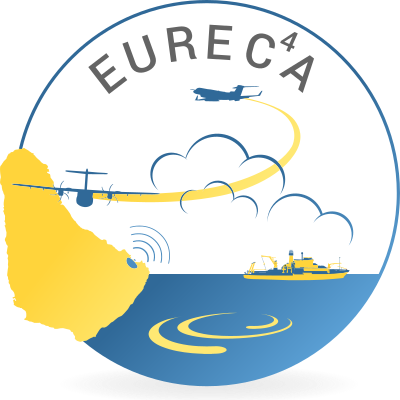Introduction#
Welcome to the world of EUREC⁴A data! This is a collection of python code examples to get you started with the data.
Idea#
The book chapters show datasets that are accessible online, i.e. you don’t have to download anything. Most datasets are accessed via the EUREC⁴A intake catalog, which simply said takes care of the links to datasets in their most recent version. The scripts typically contain at minimum how to get a specific dataset and some simple plots of basic quantities. Most chapters include additional information from aircraft flight segments or further EUREC⁴A meta data, sometimes more sophisticated plots, or also a combination of variables from different datasets.
How can you run the code?#
If you want to try out the code on your machine, you’ll need a few libraries to access the referenced data.
The easiest way to set this up would be to install the eurec4a package with the data option, e.g.:
pip install eurec4a[data]
afterwards, you should have everything installed to access the data. For some examples, you may have to install additional libraries for some specialized plotting methods. If you are looking for detailed instructions to set up the entire book project including all dependencies, please refer to running How to EUREC4A locally.
use of IPFS
We use IPFS to access data in a reliable way. In principle, this works with or without a local IPFS node (e.g. Desktop or CLI). We recommend to run a local node: this will result in data access performance generally better than more classical ways of access (e.g. OPeNDAP, HTTP), whereas without a local node, access performance can be really poor.
See Data on IPFS for details on this topic, and options to bypass IPFS.
If you want to give the chapters a really quick try and don’t want to set up anything yourself, you’ll find a rocket icon () in the top bar to the right of each chapter. The icon provides two interactive ways to run the code: Binder and LiveCode. In both cases a virtual environment is created for you in the background by a click on the respective link and you don’t have to take care of any requirements locally on your machine.
In principle, we anticipate to have at minimum one example script per instrument and we are very happy about contributions by you :) If you miss some information that could be valuable, feel free to check the link on how to contribute to this book and make a pull request or open an issue on github if you are short on time. Thanks!
Useful links#
A list of links to general information about EUREC⁴A:
EUREC⁴A overview papers: Bony et al. (2017) and Stevens et al. (2021)
AERIS leaflet(data visualization)
License#
The how to EUREC⁴A book is licensed under:
MIT License
Copyright (c) 2021, EUREC⁴A community
Permission is hereby granted, free of charge, to any person obtaining a copy of this software and associated documentation files (the “Software”), to deal in the Software without restriction, including without limitation the rights to use, copy, modify, merge, publish, distribute, sublicense, and/or sell copies of the Software, and to permit persons to whom the Software is furnished to do so, subject to the following conditions:
The above copyright notice and this permission notice shall be included in all copies or substantial portions of the Software.
THE SOFTWARE IS PROVIDED “AS IS”, WITHOUT WARRANTY OF ANY KIND, EXPRESS OR IMPLIED, INCLUDING BUT NOT LIMITED TO THE WARRANTIES OF MERCHANTABILITY, FITNESS FOR A PARTICULAR PURPOSE AND NONINFRINGEMENT. IN NO EVENT SHALL THE AUTHORS OR COPYRIGHT HOLDERS BE LIABLE FOR ANY CLAIM, DAMAGES OR OTHER LIABILITY, WHETHER IN AN ACTION OF CONTRACT, TORT OR OTHERWISE, ARISING FROM, OUT OF OR IN CONNECTION WITH THE SOFTWARE OR THE USE OR OTHER DEALINGS IN THE SOFTWARE.
